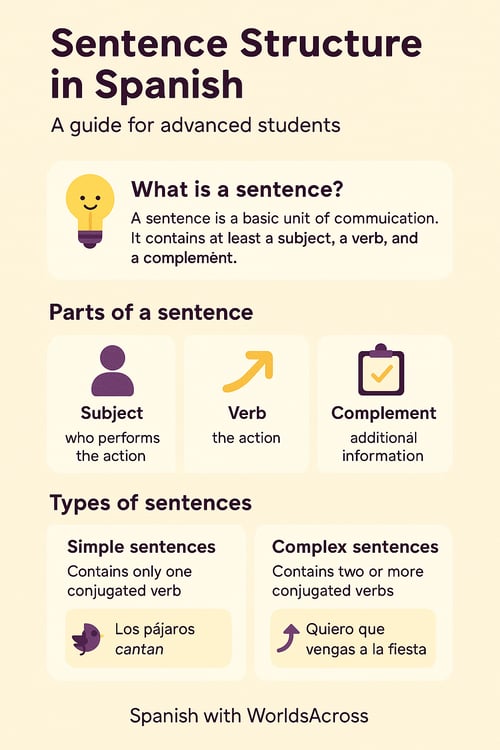Sentence Structure in Spanish: A Guide for Advanced Students

Words are like bricks and sentences like houses; you need to know how to stack the bricks correctly so the walls don't collapse. Imagine a wobbly wall—something similar happens with communication when we don't use its elements properly. However, don't worry, at WorldsAcross you will learn to use them and become a master of advanced sentences in Spanish. A solid house requires a good structure, so stay with us and learn about sentence structure.
What is a sentence?
Communication consists of several elements: sender, receiver, code, message, channel, noise, feedback. Among these, the message is the focal point of communication and is conveyed through the sentence.
A sentence is a basic unit of communication that allows us to transmit information, thoughts, and emotions. On a more technical note, it is a grammatical unit and a syntactic structure that contains at least a conjugated verb, a subject, and a predicate. To easily identify it while reading, consider that every sentence begins with a capital letter and ends with a period.
If we speak well, we understand each other better! Why is it important to learn sentence structure?
It's essential to properly arrange the words in a sentence to effectively convey the intended message. While we can communicate without respecting sentence structure, we'd end up talking like Yoda. If your goal is to use advanced Spanish sentences correctly, we’ll show you how to structure them.
To understand the whole, let's start with the parts. Parts of a Sentence
These are the three main elements of a sentence:
- Subject: who performs the action of the verb (noun or pronoun).
- Verb: the action performed by the subject or its state.
- Complement: what accompanies the verb to complete its meaning.
Complements are classified into three types: direct, indirect, and circumstantial.
- Direct complement: directly receives the action of the verb.
Example: Brian leyó el libro
- Indirect complement: indicates the recipient or beneficiary of the action.
Example: Los niños le enviaron chocolates a su abuela.
- Circumstantial complement: provides information about the circumstance in which the action takes place.
Example: Charles estudia por la noche.
Two Main Types of Sentences
Ready! Now that we know the parts of a sentence, we can move to the next level: learning the types of sentences. There are simple sentences and complex sentences. So, let's explore them further:
Simple Sentences
These contain only one conjugated verb. Structure: subject + verb + complements (if any) or predicate.
Examples:
- a) Elen come una manzana.
- Subject: Elen
- Verb: come
- Direct complement: una manzana
- b) Los pajaros cantan.
- Subject: Los pajaros
- Verb: Cantan
Complex Sentences
These contain more than one conjugated verb; therefore, they are formed by two or more simple sentences.
Complex sentences are also classified into three types: coordinated sentences, subordinated sentences, and juxtaposed sentences.
As we mentioned earlier, there are two main types of sentences, but to learn about sentence structure and create advanced sentences in Spanish, we need to delve deeper. Therefore, if we look closely at sentences, we’ll understand that both coordinated and subordinated sentences are further divided into subtypes:
Coordinated Sentences
These are joined by coordinating conjunctions, without a semantic dependency.
- Copulative: joined by an additive coordinating conjunction: 'Y'.
Example: Andrea canta y Ana baila.
- Disjunctive: present options or alternatives, using the conjunctions 'O' and 'U'.
Example: Estudias o trabajas.
- Adversative: express opposition or contrast, using conjunctions like 'pero', 'aún', 'aunque', 'sin embargo', 'no obstante'.
Example: Quería salir pero estaba lloviendo
- Explanatory: one part explains the other, using conjunctions like 'es decir', 'mejor dicho', 'o sea', 'esto es'.
Example: es un buen amigo, es decir, siempre está ahí cuando lo necesitas.
Subordinated Sentences
These are joined by subordinating conjunctions or relative pronouns and depend on another sentence to complete the meaning.
- Substantive: the subordinate clause functions as a noun/subject.
Example: Quiero que vengas a la fiesta.
- Adjective: the clause functions as an adjective, qualifying a noun or subject.
Example: El libro que me prestaste es interesante.
- Adverbial: functions as an adverb, indicating time, place, manner, cause, etc.
Example: Cuando llegues, llámame.
Juxtaposed Sentences
These sentences are joined solely by punctuation marks.
Example: La noche caía lentamente, las estrellas brillaban en el cielo.

In summary, understanding sentence structure is fundamental to mastering Spanish. This knowledge not only improves our communication skills but also allows us to appreciate the richness and diversity of the language. Whether we are writing a letter, engaging in a conversation, or simply enjoying a good book, understanding sentence structure enables us to express ourselves clearly and precisely.
At WorldsAcross, we are here to help make learning Spanish an enjoyable and accessible experience. Our team of experts and personalized resources are designed to guide you every step of the way, making sentence structure and other aspects of the language come naturally to you.
Dare to cross borders with WorldsAcross and transform your way of communicating!




